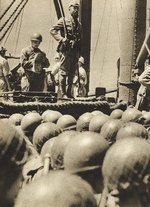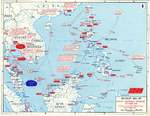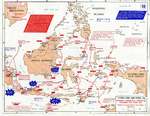Dutch East Indies Campaign, Borneo
Contributor: C. Peter Chen
ww2dbaseMiri, a city in Sarawak located in northern Borneo, fell to 2,500 Japanese invaders on 17 Dec 1941, after two days of fighting. The small garrison of Dutch troops were no match for the Japanese. A week later, the Japanese 35th Infantry Brigade and 124th Infantry Regiment led by Major General Kawaguchi headed for the Sarawak capital, Kuching.
ww2dbaseBorneo, the third largest island in the world, was known for its rich natural resources, including oil. The location was also of strategic value, as the island stood in the path of shipping between East Asia and Australia, to India, and to west beyond. Also, in the age of aerial warfare, the short distance between Kuching and Singapore meant the capture of the capital city would allow Japan ready access to attack Singapore and Malaya by air from another base.
ww2dbase"The best I could do was to promise to send them a few anti-aircraft guns... not that I expected anti-aircraft guns to be much practical value", said Lieutenant General Arthur Percival in 1941 regarding British Borneo's defenses against a possible Japanese invasion. Perhaps as a result of his belief, the Japanese air support to the ground troops went largely unchallenged. The Japanese troops arrived at Kuching on 24 Dec, but only to find the airfields at Kuching destroyed by the British before their retreat. At day break on Christmas Day, Japanese troops fully controlled the city of Kuching, and captured a stock of fuel oil to replenish their supplies. By 31 Dec, most of British and Dutch troops retreated to the Dutch airfield at Singkawang II. Northern Borneo was to be completely under Japanese control after the 6 Jan 1942 Japanese landing at Brunei Bay.
Empire of Japan Netherlands Commanders Strength Over 6,600 Over 1,300 Casualties 255 killed All killed in battle or executed after surrenderingww2dbaseOn 11 Jan 1942, one day after Japan declared war on the Netherlands, Major General Shizuo Sakaguchi's troops landed on the island of Tarakan just off the northeast side of Borneo, aiming to take control of the 700 oil wells, oil refinery facilities, and airfields on it. Lieutenant Colonel S. de Waal, commander of the Dutch garrison on the island, detected the invasion fleet a day before the landing, and decided to destroy oil fields before the Japanese could capture them. After mounting a brief resistance, Colonel Kyohei Yamamoto's troops and the men of the 2nd Kure Special Naval Landing Force established a strong beachhead and penetrated the Dutch defense. The Dutch defenders that still remain surrendered on 12 Jan, but were executed by the Japanese in retaliation for the destruction of the oil fields.
ww2dbaseBalikpapan, a coastal city on the east coast of Borneo, was the center of Borneo's oil industry. It was cut off from the rest of Borneo by terrain, so that Rear Admiral Shoji Nishimura's Fourth Destroy Squadron was tasked to cover a landing operation to take the city. Nishimura's convoy survived a submarine attack by USS Sturgeon without much damage, and reached Balikpapan to unload the troops. As Nishimura's ships went off to chase down false signs of Allied destroyers, United States Navy's Task Force 5 of the Asiatic Fleet under the command of Rear Admiral William Glassford showed up and attacked the landing forces amidst the vulnerable unloading phase. The four American destroyers opened fire at a long range, and the shots were inaccurate. When they approached the Japanese ships and launched their torpedoes, scores of them were defective. They only managed to destroy one of the three Japanese patrol boats and four of the twelve transports present, though to their credit they did manage to delay Japanese landing operations and gave the defending troops on land a bit more time to prepare the defenses. Balikpapan fell on 24 Jan.
ww2dbaseThroughout the following few months, Japan repeated attacks on Singkawang II, but the British 2nd Battalion's 15th Punjab Regiment fought back fiercely, holding their ground. Allied forces there surrendered on 1 Apr 1942.
ww2dbaseSources: The Pacific Campaign, Wikipedia, WW2 People's War.
Last Major Update: Jul 2007
Photographs
 |
Maps
 |  |
Dutch East Indies Campaign, Borneo Timeline
| 14 Dec 1941 | 10 Japanese troop transports departed Cam Ranh Bay, Indochina, with the Borneo invasion force on board. The convoy was escorted by 3 cruisers and 6 destroyers. |
| 16 Dec 1941 | Japanese troops landed on British Borneo at 0500 hours and captured the oil fields at Miri and Seria and the oil refinery at Lutong. British and Dutch authorities began to issue orders to destroy other oil related facilities to avoid further capture. |
| 17 Dec 1941 | Japanese troops landed at Sarawak; British troops nearby, not strong enough to counter the Japanese offensive, destroyed oil refineries and withdrew. |
| 18 Dec 1941 | A Dutch Do 24 bomber attacked and sank Japanese destroyer Shinonome off Miri, Borneo, killing all 219 aboard. |
| 22 Dec 1941 | In Sarawak, a Japanese invasion force departed Miri for Kuching. |
| 23 Dec 1941 | Japanese troops landed at Kuching, Sarawak. |
| 24 Dec 1941 | Japanese troops captured the town Kuching, Sarawak at 1600 hours after heavy fighting against troops of the Indian 15th Punjab Regiment. |
| 25 Dec 1941 | Japanese troops captured the British airfield near Kuching, Sarawak at 1640 hours. |
| 26 Dec 1941 | Dutch B-10 bombers from Samarinda, Dutch Borneo sank Japanese minesweeper W6 and collier Unyo Maru off Kuching, Sarawak, British Borneo. |
| 27 Dec 1941 | British and Indian troops originally based in Kuching, Sarawak, island of Borneo fled into Dutch territory. To the north, Japanese troops captured the Tambelan Islands, Dutch East Indies, which was the first Dutch territorial loss in the Pacific War. |
| 29 Dec 1941 | British troops, Indian troops, and civilians from Kuching, British Borneo arrived at Singkawang II airfield in Dutch Borneo. The British and Indian troops were incorporated under Dutch command to bolster the airfield's defenses, while the civilians were sent further south to Pontianak to await further evacuation. |
| 30 Dec 1941 | Three British Blenheim aircraft from Singapore airdropped 900 pounds of food and ammunition over Singkawang II airfield in Dutch Borneo for the British, Dutch, and Indian troops there. |
| 7 Jan 1942 | A Japanese invasion force departed Davao, Mindanao, Philippine Islands for Tarakan, Dutch Borneo. |
| 11 Jan 1942 | Japanese troops began the campaign against the Dutch East Indies by landing on Tarakan island off Borneo. In the face of superior forces, Dutch commanders at Tarakan decided to destroy the 700 oil wells present on Tarakan to prevent enemy use. |
| 12 Jan 1942 | Japanese troops executed Dutch prisoners of war at Tarakan Island off Borneo as punishment for previous day's sabotage of oil wells. |
| 18 Jan 1942 | The Dutch began to destroy oil facilities at Balikpapan, Dutch Borneo. |
| 19 Jan 1942 | Japanese troops landed at Sandakan, British North Borneo unopposed at 0700 hours. |
| 21 Jan 1942 | Japanese Sakaguchi Detachment departed the island of Tarakan for Balikpapan, Dutch Borneo. Cruiser USS Boise, cruiser USS Marblehead, and four destroyers departed Koepang, Dutch Timor to intercept; en route, USS Boise hit a rock and USS Marblehead suffered engine trouble, thus the destroyers would sail on by themselves. |
| 23 Jan 1942 | As the Japanese convoy carrying the Sakaguchi Detachment approached Balikpapan, Dutch Borneo, it was attacked by Dutch forces; Dutch submarine K-18 sank Japanese transport Tsuruga Maru, while nine Dutch B-10 bombers, and 20 Dutch Buffalo fighters sank Japanese transport Nana Maru and damaged Tatsugami Maru. |
| 24 Jan 1942 | Dutch bombers attacked Japanese troop transports off Dutch Borneo as the ships sailed toward Balikpapan. Dutch submarine K-18 damaged Japanese patrol boat P37 and suffered damage from depth charge counterattacks. After sundown, 5,500 Japanese troops landed unopposed at two sites north and east of Balikpapan. Finally, US destroyers USS Paul Jones, USS Parrot, USS Pope, and USS John D. Ford attacked Japanese transports at Borneo, sinking Kuretake Maru, Sumanoura Maru, and Tatsukami Maru, and further damaging patrol boat P37. |
| 25 Jan 1942 | The Japanese conducted a third landing at Balikpapan, Dutch Borneo, capturing the airfield at dawn. Dutch defenders began sabotaging bridges before retreating north, where they were ambushed by a Japanese force. Meanwhile, civilians were evacuated by ship at Pontianak, Dutch Borneo. |
| 27 Jan 1942 | Japanese troops overcame Dutch and Indian troops and captured the Singkawang II airfield on Dutch Borneo; the Allied troops retreated to Ledo, 15 miles to the southwest. |
| 28 Jan 1942 | Japanese troops landed at Pemangkat, Dutch Borneo. At Balikpapan, part of the assault force for Bandjermasin, the capital of Dutch Borneo, departed by transports. |
| 30 Jan 1942 | 400 Japanese troops landed at Adang Bay and began a 155-mile trek across jungles to assault Bandjermasin, the capital of Dutch Borneo. |
| 7 Feb 1942 | USAAF B-17 bombers from Java, Dutch East Indies unsuccessfully attacked Japanese shipping off Balikpapan, Borneo, Dutch East Indies. |
| 8 Feb 1942 | Japanese troops landed 50 miles southeast of Bandjarmasin, Dutch Borneo and began marching toward the Martapoera airfield. |
| 13 Feb 1942 | Japanese troops captured Bandjarmasin, the capital of Dutch Borneo, unopposed. |
| 20 Feb 1942 | Japanese troops massacred 72 Dutch prisoners of war and 2 Dutch civilians at Balikpapan, Borneo, Dutch East Indies by beheading and gunfire for the destruction of oil facilities prior to Japanese occupation. |
Did you enjoy this article or find this article helpful? If so, please consider supporting us on Patreon. Even $1 per month will go a long way! Thank you. Share this article with your friends: Stay updated with WW2DB: |
Visitor Submitted Comments
11 Dec 2007 11:30:02 PM
I need information on Captain Watanabe, Colonel Watanabe, and Colonel Saguchi that were assigned in Sulu, Philippines, during WW2. can you help?
12 Apr 2009 07:05:42 AM
Col. Watanbe surrended his Samurai sword to my Grandfather in Osaka,Japan four days after the surrender of WW2. Is this the same officer?
23 Mar 2010 03:01:01 PM
I am also looking for information on a Colonel Watanabe who was in Bontoc, Mt. Province, Philippines. I would like to know if he survived the war and, if so, what may have happened to him.
14 Jan 2017 02:40:41 PM
I do not read the story of the disaster from january 13th 1942 and the destroying of The Glenn Martin bombers by the Japanes zero's.
2 Apr 2019 07:28:25 PM
Apparently, the Borneo oil was so low in sulfur (sweet) that the Japanese ships could pump it into their bunkerage, without refining.
3 Mar 2021 04:45:23 AM
My father (he was 10) and his family were evacuated from Miri Sarawak just before the Japanese invaded. My father was full of wild stories, and one of them was that he and his brother got separated from his parents and ended up in Australia - does anyone know anything about this earlier evacuation or have any thoughts about how I might chase this tale down?
All visitor submitted comments are opinions of those making the submissions and do not reflect views of WW2DB.
» Daigo, Tadashige
» Ito, Kiyoshi
» Nishimura, Shoji
» Sakai, Saburo
Locations:
» Brunei
» Dutch East Indies
» North Borneo
» Sarawak
Ship Participants:
» Kinu
» Kumano
» Minegumo
- » 1,146 biographies
- » 336 events
- » 43,422 timeline entries
- » 1,237 ships
- » 349 aircraft models
- » 207 vehicle models
- » 372 weapon models
- » 123 historical documents
- » 259 facilities
- » 468 book reviews
- » 28,395 photos
- » 432 maps
Chiang Kaishek, 31 Jul 1937
24 Apr 2007 08:41:24 AM
i know a guy who died in Vietnaham